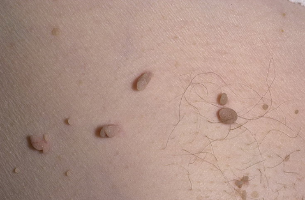Papilloma is a lesion of the skin and mucous membranes caused by the human papillomavirus.
Causing agents - genus papilloma virus viruses. Currently, more than 60 variants are known about them, 32 are recognized as causing the disease.
Transmission routes - contact (through skin microtrauma), genital, perinatal (during childbirth).
Manifestations of papillomas

- Subcutaneous papilloma (warts).
Most often on the hands, less often on other parts of the body. Localized lesions are common in children and adolescents. In immunocompromised patients, wart damage may spread. The incubation period is 1-6 months. Maximum virus content in affected tissues is observed 6 months after infection. - Vulgar (simple) papilloma.
Their causative agent is human papillomavirus (HPV). This form is manifested by heavy bumps, rough surface 1 mm in diameter or more, with a tendency to merge. Vulgar papilloma often covers a large area. They can appear anywhere, but they are more often located on the back of the palms and fingers, in children - on the knees. Single papilloma can exist for months or even years, virtually unchanged, but it is also possible for the process to spread rapidly. There are isolated cases of papilloma degeneration in the tumor. Immunodeficiency states facilitate the spread of the process. - Plantar papilloma.
The causative agents are HPV-1 (deep form), HPV-2 (mosaic warts) and HPV-4 (minor lesion). The process begins with the appearance of a small, shiny bump, acquiring the characteristics of a typical papilloma surrounded by an apical ring. Sometimes, in one papilloma, many virginal formations appear, resembling bubbles - mosaic warts. Plantar papilloma can be painful and difficult to walk on. The duration of their existence is different. In some cases, especially in children, spontaneous disappearance of any number of papillomas is possible. This form of the disease is often confused with calluses, which are manifested in areas of pressure between the fingers or toes. Corns, unlike papillomas, have a smooth surface that has a skin pattern. - Flat papillomas.
Their causative agents are HPV-3 and HPV-10. They are represented by smooth bumps of normal skin color (light yellow or slightly colored). They can be round or polygonal in shape. The appearance of flat papillomas, mainly in children, is usually accompanied by itching, inflammation of the affected area, redness, pain. - Slab-shaped papillomas. The process begins with the appearance of small yellowish or slightly colored cones, then expand and turn into dense dense elastic formations up to 5-6 mm in size. In areas of possible trauma, the papilloma may be inflamed. Their spontaneous disappearance does not occur.
- Local epithelial hyperplasia (Beck's disease).
The causative agents are human papillomaviruses 13 and 32. The disease was first described in the American Indians. Observed on the mucous membranes of the mouth, tongue, lips in the form of small papillary eminences. - Genital warts.
The causative agents of genital warts are human papilloma viruses with low (6, 11), moderate (31, 33, 35) and high (16, 18) oncological risk. Viruses are sexually transmitted. The incubation period lasts from a few weeks to a month. In some cases, the damage is minimal, often going unnoticed. Infected cells are prone to malignant degeneration. In most cases, the long and widespread process is accompanied by immunodeficiency conditions.
Cervical cancer is most commonly diagnosed in women with genital warts. In most cases, regardless of the age of the patients, the viral genome is detected by DNA hybridization. The causative agent is HPV-18.
Juvenile papillomatosis of the larynx. The causative agents are HPV-6 and HPV-11. They are rarely recorded. In most cases, papillomatosis is detected in children older than 5 years who are infected in the mother's birth canal. There is a characteristic increase in vocal cords, which leads to speech difficulties and air circulation disorders in the upper respiratory tract.
Treatment of papillomas
The same symptoms may be signs of different diseases, and the disease may not continue according to the guidelines. Do not try to cure yourself - consult a doctor.
Currently, there is no single international standard for the treatment of papillomas. So far official treatment guidelines include
- Cytostatics (antineoplastic agents),
- Cryo laser,
- electrical destruction.
but they are not always effective and are accompanied by relapses.
Other treatments for papillomas:
- For subcutaneous and vulgar (simple) papillomatosis - surgical removal (cryodestruction, laser removal with correction of immunity).
- Plantar - cryodestruction, laser and / or dithermocoagulation.
- Mosaic papilloma is the most difficult to treat. When they disappear, especially in children, there are signs of inflammation.
- For flat forms - Cryotherapy with immune correction.
- for fibrillation - for diathermy coagulation.
- In local epithelial hyperplasia, cryotherapy with immune correction.
- In case of subcutaneous abdominal dysplasia, cryotherapy or dithermocoagulation with further correction of immunity.
- In case of genital warts - removal of warts with cryotherapy, laser excitation or diathermy coagulation and mandatory correction of the immune system.
Treatment of genital papillomas can be difficult with other infections of the genitalia (chlamydia, bacterial vaginosis, herpes, CMV infection, etc. ). In these cases the treatment is carried out in parallel.














































































